Tour - Electr(on)ics
Sound for the V200
A preliminary test of the module prior to its mounting revealed some less desirable facts. A useful sound was impossible to produce on the module's first startup - the Lehmann/Massoth-modules behave differently. The module began to play the startup sounds but aborted the procedure after a couple of seconds and started over again ... and again and again. As the slips (the term manual were a wording too friendly) accompaning the product did not mention such a behaviour, I had to investigate a bit on my own. Result: Decrease the volume and use a power source more effective than the LGB 1A-transformer. Then the sound does work - at least for the moment. The reason why the module refuses operations when the volume control is turned to its maximum remains the manufacturer's secret.
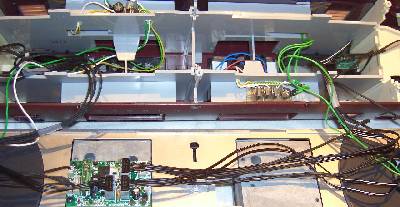
Removed housing
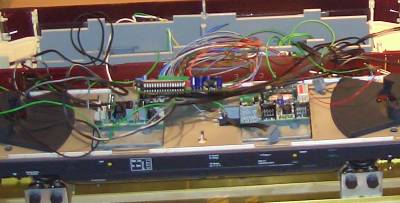
First tests - and where do I mount which parts ?
Based upon the criticism regarding Lehmann's sound modules posted on several forums, I had expected a significantly different or even a better sound quality - an obviously baseless expectation.
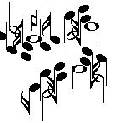

The operating noises sound a bit indistinct under test conditions and there
was no engine shutdown sound (as opposed to LGB's V51). Sound off, done.
I should mention, that this fault was corrected by Dietz after some weeks.
Exceedingly positive to mention are the whistle's and the horn's sound.
Next surprise: The starting sound wasn't played any longer. Supplying power to the beast resulted in the sound of an already running engine immediately. The attempt to "read the programmer's mind" resulted in the finding that there had to be a "significant" difference between the track and the motor voltage before the loco starts moving... And right - disconnecting the motor from the module and supplying voltage to the module then resulted in a reappearing starting sound. An additional board from a V51 was expected to solve this problem... Hints regarding this behaviour in the accompaning slips of paper ? No such luck.
Next surprise: The starting sound wasn't played any longer. Supplying power to the beast resulted in the sound of an already running engine immediately. The attempt to "read the programmer's mind" resulted in the finding that there had to be a "significant" difference between the track and the motor voltage before the loco starts moving... And right - disconnecting the motor from the module and supplying voltage to the module then resulted in a reappearing starting sound. An additional board from a V51 was expected to solve this problem... Hints regarding this behaviour in the accompaning slips of paper ? No such luck.
Control of motors and lights
Considerations to use only the board from the V51 for these purposes were deprecated due to the fact that controlling the V200's lights was not easy to implement with this board. Therefore this board was integrated to just control the motors:Both of the motors were disconnected from the original V200 DCC interface board and connected to the corresponding output terminals on the V51 board. The motor outputs of the V200 board were connected to the V51 board's track input terminals. As a result the starting delay now worked and the red tail lights came up while the loco stood still. Unfortunately, the head lights remained dark. The LEDs used for the head lights apparently are blue or UV-LEDs with a photoluminescent material which need a voltage of approx. 4V to light up... A further reduction of the voltage supplied to the motors by inserting suitable diodes into the leads helped to have also the head lights come up while the loco stands still.
A more or less poor solution which meanwhile has been replaced by a real starting delay.
A brief analysis of the operating mode switch revealed that switch position "3" is just used to provide power (taken from the in left rail in direction of travel) to a single pin on the V200's DCC interface board. The sound module was connected to this pin so that it can be switched on and off using the loco's operating mode switch.
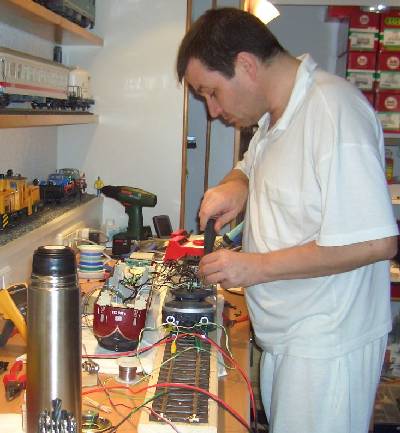 Lord of the cords
Lord of the cords
Mounting the parts
Three 2mm-drillings were applied to the second metal weight to mount the V51 board. This way the metal weight was a heat sink for the transistors, too. Afterwards the above described wiring was implemented. A home for the sound module and its power storage was found in the loco's housing - mounted upside down. This required a seperate mounting of the power storage board as its connector didn't appear to be suitable for a permanent "upside down operation". A flat cable with a suitable plug was used to reestablish the connection between both of the boards.One of the sound module's track connection cables was soldered to the pin of one of the motor blocks corresponding to the right rail, the other one to pin "3" of the operating mode switch. The module's motor connection cables were soldered to the motor pins of the same motor block. Some minor modifications were applied to the metal weights as well as to the housing's screw joints in order to fit the speaker into its intended place. Finally, a cover frame was made for the speaker to prevent undesired emergence of sound - which had a really positive influence on the sound's quality !
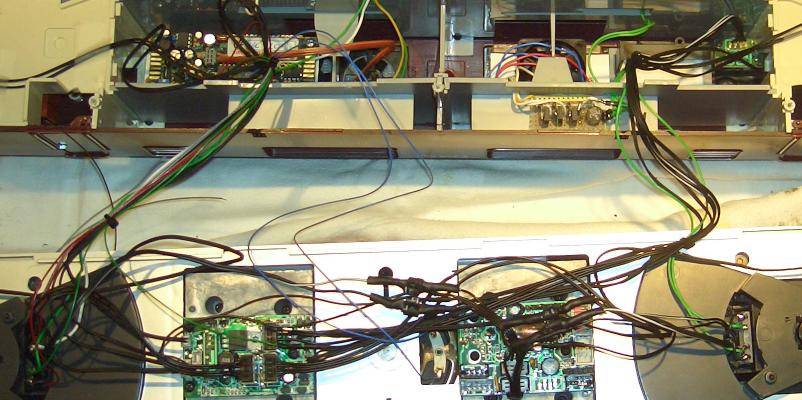
Mounted and wired components - just the reed-switch is missing. Inside the housing fltr: Sound module, engine compartment illumination, operating mode switch. On the chassis: V200 DCC interface board, speaker terminals, V51 motor control
Last act
After the reed-switch (used to trigger the whistle and the horn) had been delivered, its housing had to be modified in order to fit beneath the loco's drives. The mounting arms and the cover were removed.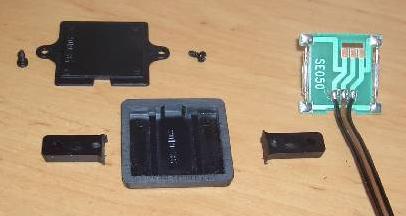
Reed-switch board and partially modified housing parts

The drive unit had to be opened for installing the cable
The drive unit was opened to look for possibilities regarding the cables installation. Since there is plenty of space, the flat cable can be led through it, after applying a drilling in both the drive's bottom and top covers.
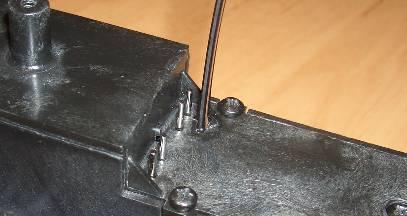
The cable escaping the drive unit
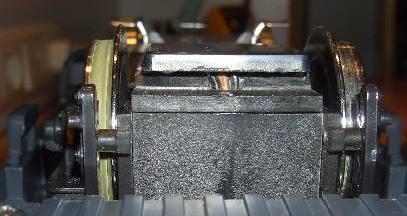
Mounted board with cover
A bit of the board's housing height had to be abraded so that it fitted under the drive unit. Mounting was accomplished with a cyanoacrylate adhesive.
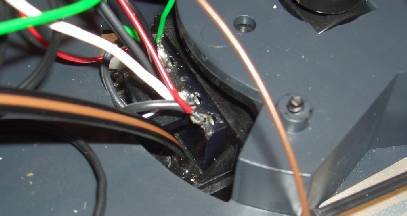
Existing structures were used for installing the reed-switch cable
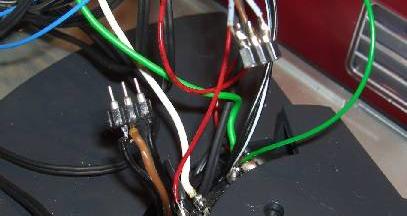
SIL multipoint connector converted into a plug-and-socket connector
The place where the reed-switch cable emerges the drive unit was chosen near the unit's original terminals so that the chassi's existing structure could be used to lead the cable into the loco's interior. A plug-and-socket connector was inserted into this cable to keep the unit dismountable.
Summary
The Dietz sound module's operation in analogue mode does not really compare to the modules from Lehmann/Massoth, which is due to the different power supply designs. The root cause for this is that the Dietz module works best at at least 10V - but it also works fine below this value if the terms of operations and parameters are adjusted to the design of the module's construction and software. The power storage module for playing the standing sounds works flawlessly if one does not expect to be presented with a starting sound after pausing operations for some time, say days or weeks. In my ears, the sound itself is neither better nor poorer than that from Lehmann or Massoth respectively. Instead of a manual there only is a collection of slips for non-techies.Now the loco hums marvelously and magically invokes a smile on its owner's face when the din starts.
The installation's minor challenges already are forgotten.
Back to selection | Next topic

